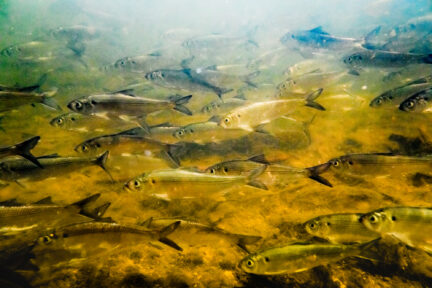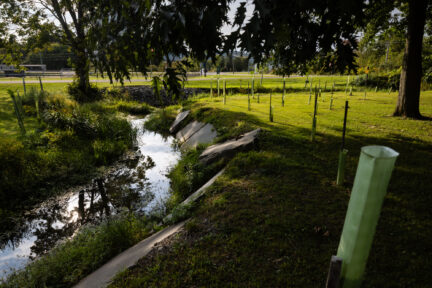Bay Program Partners Continue Progress to Stem the Flow of Excess Pollutants to the Chesapeake
Bay Program Partners Continue Progress to Stem the Flow of Excess Pollutants to the Chesapeake
New 2012 data released today by the Chesapeake Bay Program (CBP) partnership estimates that actions taken by jurisdictions in the last three years resulted in less nitrogen, phosphorus and sediment pollution flowing into the Chesapeake Bay.
Chesapeake Bay Program partners–the District of Columbia and the six states in the Bay watershed–report annually on actions they’ve taken to decrease the amount of these three pollutants entering rivers and streams. This information is analyzed using a sophisticated suite of computer simulations of the Bay ecosystem. The resulting estimates tell us how much progress their pollution-reducing actions have made toward levels that would sustain a healthy Bay. By 2017, CBP partners are committed to having practices in place to achieve at least 60 percent of necessary reductions from 2009 levels.
Facts
Simulations of pollution reducing efforts put in place between July 2009 and June 2012 estimate CBP partners have achieved 25, 27 and 32 percent of nitrogen, phosphorus and sediment reductions needed by 2025, respectively.
Nitrogen loads to the Bay have decreased 18.5 million pounds to 264.1 million
- A further decrease of 2.9 million pounds since 2011 estimates
Phosphorous loads to the Bay have decreased 1.3 million pounds to 18.0 million
- A further decrease of 0.4 million pounds since 2011 estimates
Sediment loads to the Bay have decreased 431 million pounds to 8,244 million
- A further decrease of 35 million pounds since 2011 estimates
Issues
Excess nutrients (nitrogen, phosphorous) and sediment impair water quality and underwater habitat. It is critical to reduce the amount of these pollutants entering our waters.
Too much nitrogen and phosphorus fuel the growth of algae blooms. As the algae die off, naturally occurring bacteria use up oxygen in the water, leaving behind “dead zones” unable to support aquatic life. Excess sediment clouds the water, blocking sunlight from reaching underwater grass beds and suffocating oysters and other shellfish that can’t move to healthier waters.
Importance
CBP’s “Reducing Pollution” information offers up the most current data on our partners’ progress toward their goals of lower nitrogen, phosphorus and sediment loads entering local waters. The six Bay states, D.C. and their various municipalities can use many land-based actions to improve the health of local rivers and streams and help them reach their goals. These can range from large-scale tree plantings and habitat restoration projects to wastewater upgrades and improved agricultural practices. The annual simulation data provides managers and leaders with sound, science-based information that can help them assess what practices are most effective and adapt their decisions for the most benefit.
Partners’ progress toward improved water quality through decreased pollution results from their work to meet the limits set by the Chesapeake Bay Total Maximum Daily Load (TMDL), established in 2010, and outlined in the seven Bay jurisdictions’ Watershed Implementation Plans (WIPs). The Environmental Protection Agency oversees the jurisdictions’ progress toward these goals.
Quotes
“The Bay watershed partners continue to implement measures to reduce pollution from all sources. While we clearly have a lot of work to do, we are making progress in meeting water quality goals. Our management practices and reporting systems are improving, but the Bay ecosystem restoration effort remains precarious. We must redouble our efforts to restore balance in the ecosystem and rebuild its resilience."
--Nick DiPasquale, CBP Director, EPA
“It is great to see the Chesapeake Bay Program partners’ commitments and continuing efforts to reduce nitrogen, phosphorus and sediment pollution. Whether in urban environments such as the District or agricultural regions in other jurisdictions, it is critically important that we all continue to do our part for the health of our waters and our environment. We cannot live without water; our health and that of our communities depends upon it being as clean as we can possibly make it.”
--Keith Anderson, Chair, CBP Principals' Staff Committee and Director, D.C. Department of the Environment



